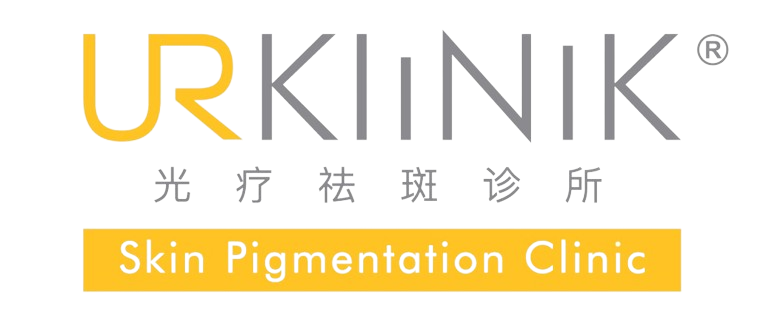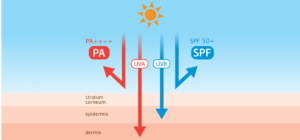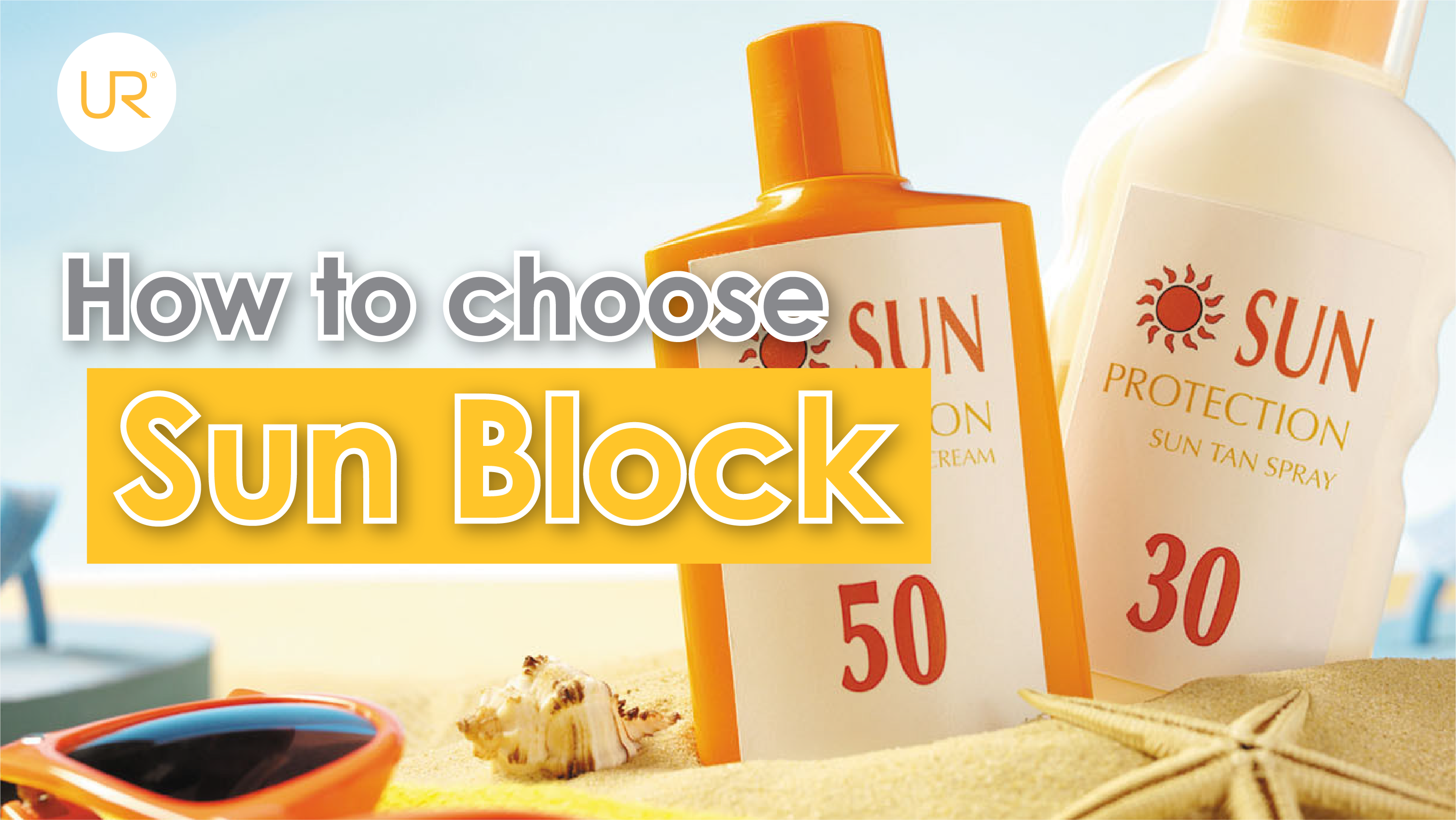
25 Oct How to choose the best sunscreen to prevent skin hyperpigmentation?
What is Sunscreen
Sunscreen, also known as sunblock, is a type of topical product for the skin which contains active ingredients that absorb/ reflect sunlight, which helps to protect our skin from UV radiation and photodamage, which is the primary cause of aging, skin hyperpigmentation and skin cancers.
To understand this better, you will first need to know
There are 3 types of ultraviolet (UV) radiation:
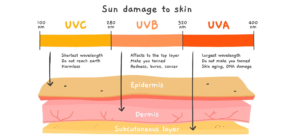
1. Ultraviolet A (UVA)
Able to penetrate deeper layers of skin and even glass. Causes immediate tanning effect, skin aging and promotes development of skin cancer.
2. Ultraviolet B (UVB)
Penetrates up to the superficial skin layer. Unable to penetrate through glass. Causes sunburn, skin aging, and promotes development of skin cancer.
3. Ultraviolet C (UVC)
Unable to penetrate through the ozone layer of the Earth. Most dangerous type of UV radiation which causes skin cancer.
Choose a broad-spectrum sunscreen which protects you from both UVA & UVB radiation.
What is SPF and PA?
If you are paying attention to your sunscreen products, most probably you will find the words “SPF” and “PA” on the product labeling.
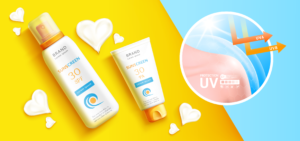
SPF, Sun Protective Factor
SPF is a measure of the amount of UVB radiation required to cause sunburn on protected skin in the presence of sunscreen, relative to unprotected skin.
For example, by wearing sunscreen with SPF 15, it takes 15 times longer to cause sunburn than if you are not wearing sunscreen. Let’s say it usually takes 10 minutes to cause sunburn, by wearing sunscreen with SPF 15, it takes 150 minutes to cause sunburn.
So, is sunscreen with a higher SPF better?
- SPF 15 blocks 93% of UVB rays.
- SPF 30 blocks 97% of UVB rays.
- SPF 50 blocks 98% of UVB rays.
It is recommended to use sunscreen with an SPF of at least 30. For daily usage, sunscreen with SPF of 30-50 is sufficient.
Higher-number SPF blocks slightly more UVB rays, but no sunscreen can block 100% of UVB rays. Sunscreen with higher SPF may create a false sense of security. No matter how much the SPF is, the duration of the effect of sunscreen after being applied is still the same, and reapplication is needed for optimum sun protection.
PA, Protection Grade of UVA
It is a rating system developed to measure the intensity of UVA protection the product offers. Amongst UVA, UVB and UVC, UVA is the type of UV ray that causes the skin to turn brown. Hence, PA measures how the sun’s UVA rays cause the skin to become brown and stay brown through a process called Persistent Pigment Darkening, or PPD. So what does it mean with the ‘+’ label follows the word ‘PA’ for example, PA+, PA++, PA+++
This is what each PA means:
- PA+= some UVA protection
- PA++= Moderate UVA protection
- PA+++= High UVA protection
- PA++++= Extremely high UVA protection
In general, a sunscreen with SPF30 and PA +++ or above will keep you protected from UV rays damage, provided it is applied correctly.
How many types of sunscreen?
Physical sunscreen (also known as mineral sunscreen)
Works by acting as a physical barrier that reflects the UV rays away. It forms a protective barrier on the skin surface and is not absorbed into the skin. It is mostly formulated with zinc oxide and titanium oxide which reflect and scatter UV rays. These two mineral-based ingredients are recognized as safe and effective by the Food and Drug Administration (FDA).
Furthermore, zinc oxide is also recommended for sensitive skin and is safe for children. Hence, physical sunscreen poses lower risk of irritation to your skin.
It is also ideal if you need to apply your sunscreen and quickly go under the sun as it starts working immediately, as opposed to chemical sunscreen which takes around 30 minutes after application to work.
Chemical sunscreen
Penetrates the skin, and it works by absorbing the UV rays and converting them into heat which are then released back to the environment. The common ingredients are oxybenzone, dioxybenzone, avobenzone, octocrylene, homosalate, octinoxate and other chemicals. Chemical sunscreen is easier to apply and does not leave behind white residue like physical sunscreen. It is also lighter and hence is more suitable for oily skin.
Which is the best sunscreen?
Choose a broad spectrum sunscreen which protects you from both UVA and UVB rays, SPF of at least 30 and above (SPF around 30-50) and PA+++. It is preferable to choose a sunscreen which is fragrance free and paraben free especially for sensitive skin.
How much sunscreen is enough?
It is recommended to apply a finger (from tip to first finger crease) of sunscreen on your face, which equates to the size of a nickel or 1/4 to 1/3 of a teaspoon. Do not forget your neck, area behind your ears, temples and hairline.
When to apply sunscreen?
Regardless of the weather (sunny, cloudy, rainy or winter), sunscreen is a must as UV rays can pass through clouds.
Depending on the choice of your sunscreen, for chemical sunscreen, application should be approximately 15-30 minutes before being in the sun (for best results) so that it can be absorbed by the skin and less likely to wash off when you perspire. However, physical sunscreen offers immediate protection which means no waiting is required before you head out under the sun!
How to apply?
The way you apply sunscreen can ensure you receive maximum coverage. First apply your skin care products, next apply your sunscreen and lastly apply your makeup, if desired.
How frequent application is optimum?
Reapply every 4 hours indoors and every 2 hours outdoors, after sweating or swimming. The reason you have to reapply is that sunscreen breaks down as it blocks UV rays. Even if you are using water-resistant sunscreen, reapplication is still needed.
How to reapply sunscreen over makeup?
Powder sunscreen or spray sunscreen are good options for reapplication of sunscreen over your makeup.
Gently brush powder sunscreen over your makeup provides a matte finish without smudging your foundation.
You can also easily mist your face with spray sunscreen which does not ruin your makeup. However, make sure that the sunscreen is actually landing on your skin and does not get carried away by the wind to the environment.
Can I use makeup with SPF?
Applying makeup with SPF (such as foundation, compact powder, BB cream or CC cream) alone is insufficient for sun protection as most people do not apply enough amount to have sufficient sun protective effect. However, they are good options for touching up your makeup or for additional sun protection.
Is sunscreen safe for long term application?
No studies have yet concluded that long-term sunscreen use will lead to negative side effects.
However, for infants younger than 6 months old, sunscreen is not recommended as infants’ skin are more sensitive than adults’ and may possess greater risk of side effects such as rash. Infants’ sensitive skin is susceptible to serious sunburn, hence the Food and Drug Administration (FDA) and the American Academy of Pediatrics (AAP) recommend keeping newborns and infants younger than 6 months out of direct sunlight.App 06(01) UR Certification Scheme -2
Thanks for reading!
At UR Klinik, experience effective pigmentation treatment in Malaysia through light therapy, rejuvenating your skin and addressing concerns such as melasma, hyperpigmentation, and dark spots.
